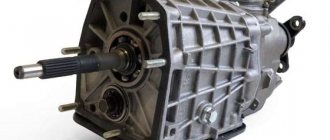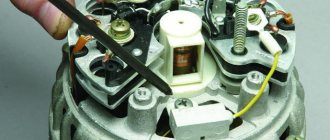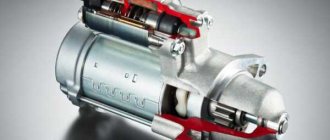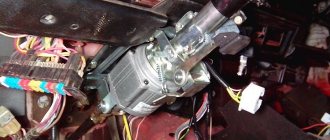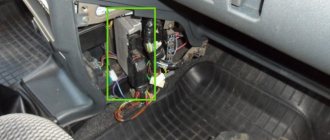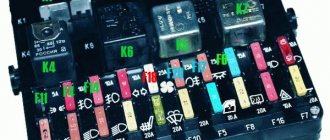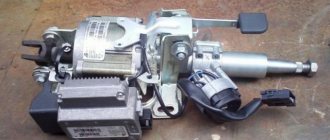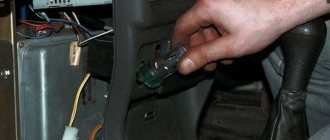#007 “The Hunger Games” or the fuel pump does not work.
Days from purchase to incident:
36 On an ordinary warm May evening, I left work, got into the car, and turned the key to the “ignition on” position. The fuel pump hummed, throwing a portion of gasoline into the engine. The engine started, accompanied by its daily convulsions, and I was already prepared for the long trip home. Having left the parking lot, I went along the broken road to look for asphalt. He was already visible at the intersection and it seemed that the wheels were about to grab him, but then the car suddenly stalled.
When trying to start again, the starter vigorously thrashed, but the engine did not catch. “Here you go!”, I thought. He got out of the car, opened the hood and, of course, looked around the engine compartment with a sensible look. The cover, covering almost the entire space, was pulled off and placed in the trunk. I didn’t notice any leaks other than the usual ones (the engine filler cap is snotty). But checking the fuel rail showed that the engine, simply, has nothing to feed on because... the ramp is empty.
Apparently, the gas pump refused to continue to resist the hardships of life under my leadership and went into desertion.
However, the first thing to do was to check the fuses, and since the car enthusiast’s Kama Sutra, as luck would have it, stayed at home, I had to call comrade Shnivovod to find out where they live and what the fuel pump fuses look like. (Sasha, thank you!)
It turned out that they live separately from the main ones, which I had already reviewed all of at this point. And since this was my first inspection of the fuses since the purchase, there were some surprises - a couple of fuses were in a terrible external condition, but strangely enough, they continued to function.
My further path lay outside the glove compartment, which was immediately dismantled and immediately showed me the desired unit with relays and fuses, as well as Bosch’s brains.
The big fuses are responsible for the fans that cool the engine when the temperature rises, and the small one on the edge belonged to the fuel pump. Everyone was safe and healthy. Just in case, all fuses and relays were checked with a multimeter - everything is alive. When the ignition was turned on, the relays clicked, and gasoline power never entered the engine. So it's the fuel pump itself.
I recline the back seat and see my fuel pump.
The cable receives power from the battery, which I verified with the same multimeter, which means all that was left was to remove the fuel pump. The cable disconnected without problems, but the fuel hoses turned out to be trickier. According to Feng Shui, you must first press the retaining bracket to the very end and gently tighten it. Awareness of this fact cost the plastic mount one of the petals. I didn’t have the head with the knob with me and the bolts holding the fuel pump housing were slowly and sadly unscrewed with a wrench.
Next, the fuel pump was removed and dragged in a bag to the workshop for inspection.
A quick inspection revealed a hose that had come off.
A black-as-night filter in an underground cave caught my attention. The quality of our gasoline has never been in doubt in my mind, and it’s very good that all this dirt settled on the filter without going further along the highway to the dryer.
While I was rinsing the filter with isopropyl alcohol and blowing it with compressed air, my colleague connected the motor to power and found out that it was more alive than anyone else, which added a significant amount of joy. (thank you, Tolyan!)
The pump, by the way, is also Boshev's. Then the filter cleaning was finished.
Just putting the tube back on and forgetting it would be unforgivable for a true samurai and, with the help of a hair dryer, it was seated.
But even this seemed to me not enough to clear the karma and I grabbed a connection for two more straps.
Now all that was left to do was return the entire structure to where it had been taken from. No sooner said than done, and the key is already sticking out hopefully in the ignition. I turn it to the “ignition on” position, but the usual buzzing sound is not heard. Sadness. I try to start the engine and after fumbling with the starter, the car comes to life. The engine thrashes and does not stall, and this is no small thing. We try the voltage with a multimeter in the “ignition on” position - there is no voltage. I turn the starter and everything is there. And the buzzing sound is in no hurry to return at the first turn of the key to take me back to the “as before” state.
I decide to go home so that in a calm environment in the garage I can poke around to my heart’s content and look for where to click to make it fun.
I throw all my things, tools, covers and generally everything that is left into the trunk. I put the key in the ignition again, turn it and hear that same coveted hum. Everything is back to normal. Except for the disassembled and gutted glove compartment. But, after driving for a day in test mode, I decided to assemble it. Not all the bolts were in place and I simply replaced them with metal screws, which fit perfectly in place of the standard ones.
It is noteworthy that I did all the work with a small screwdriver and a wrench and that was enough.
Source
The fuel pump is silent and does not pump
A fairly common option: “It’s getting cold outside. I got into the car, started it, and the car immediately stalled!” My first thought was “the fuel pump is broken.” The starter spins briskly, but doesn't grab a beat.
0) When the car is working properly, when you turn the ignition key, you hear a click from the fuel pump relay (under the glove compartment, at the passenger’s feet), after which the fuel pump hums for 4-6 seconds (increases pressure), after which the relay clicks again. Also, the relay and pump operation can be heard while the starter is running. (But due to the operation of the starter itself, it is very quiet).
In my case, the relay was audible, but the pump was silent.
But you should keep in mind that clicks and the pump will only be heard the first 2 turns of the key. After this, Boshev’s “brains” block the work of pressure, it is believed that there is pressure in the system.
You can reset the negative terminal from the battery for a few minutes (reset the “brains”). After this, the pump will turn on again.
Make sure there is gasoline in the gas tank. (although the relay will click without it, the pump will be audible even without it).
What to check, where to crawl. 1) We get under the hood. Fuel rail (where the molds are) At the end of the ramp (from the windshield side) there is a cap. Under the cap there is a spool (valve) that, when pressed, gasoline should flow from the ramp in a good stream. After several attempts to start the key, there should be a trickle. You can check with two people (one turns the ignition key, the second checks the pressure in the rail). If there is pressure, everything is fine with the fuel pump. That's not the reason.
If there is no pressure, then the problem is probably with the fuel pump.
2) Check the fuel pump fuse. It is located under the glove compartment. At the feet of the front passenger. We move the seat to the rearmost position and crawl there:
The fuse is 15 A. Sometimes the fuse is intact, but its seat is bad (it does not press well). It is recommended to carefully rotate the “legs” of the fuse.
This way the contact will be more reliable. Checking the operation of the fuel pump (by sound or pressure in the rail)
3) Check the fuel pump relay. Indirectly, a faulty fuse may be indicated by the absence of a characteristic “click”. If it “clicks”, then everything is fine with it. It is located in the same place as the fuse.
The two middle relays can be swapped. They are interchangeable. Relay 752.3777-121 For 12 V and 30 A. If there are no clicks, then there is a problem with the wiring (a break somewhere). If there are clicks, then check the operation of the fuel pump. If we don’t work, we move on.
4) there is a hatch under the rear right seat. Let's open it.
Two gas hoses and one electrical connector. We remove the connector, and the 2nd and 3rd contacts of the chip should be 12 V when the key is turned (and the starter is running). Check with a multimeter. If there is no voltage, then the circuit is open. (including you need to check the total “mass” in the trunk, at least make sure that the side lights and turn signals in the rear lights are on) If there is voltage on the “chip”, then there is something wrong with the pump itself.
5) Remove the fuel pump. It is advisable to have less than 1/3 of a tank of gasoline. I recommend tying the hoses and electrical wire so that after disconnecting from the fuel pump they do not fall into the niche. Unscrew 12 M10 nuts. We get the fuel pump.
6) Diagnostics of the fuel pump. Dry the fuel pump. Provide 12 V in home laboratory conditions. Check all terminals. Sometimes it burns noticeably:
Also check the mesh filter. If the problem is with the fuel pump, then I recommend installing a new one.
Mine lasted 8 years. If old, tired pumps are still working, they cannot create the necessary pressure (the error on the BC is “lean mixture”).
All models of fuel pumps are interchangeable. Previously they had a short glass. Now with deep. Get the latest version of the pump. Just so that the connector for connecting the electrical harness fits (but for now they are all the same). Old fuel pump 21236-1139009
Source
The starter clicks but does not turn: causes and solution to the problem
Many drivers have encountered such an unpleasant situation when the starter does not want to turn the engine and start the car.
And it’s not a matter of the battery, because even no attempts are made to move the power unit. There is just a kind of click and nothing else happens. In such a situation, you have to push start the car or come up with other ways to start the engine. If the starter clicks but does not turn, there are several types of car problems that are worth paying attention to. This problem will have to be solved immediately after it occurs, because further movement is only possible with a working starter. Especially when it comes to large cars, which cannot be started from a pusher.
The starter makes a few characteristic clicks, but does not turn the engine.
The first scenario for the development of the situation in this case will be the occurrence of several successive clicks. If you listen closer to the unit, you can understand that these clicks are produced by the traction relay. This means that the starter takes an electric charge, but the current only reaches the traction charge, without passing to the engine spin-up mechanism itself.
Such manifestations are perceived by drivers as a discharged battery. The lack of charge in the battery would allow the starter to be cranked lazily once or twice, so this problem is excluded in this case. It is better to pay attention to the following possible problems:
- the traction relay is faulty and does not supply voltage to the starter itself;
- the relay contacts with the main part of the starter are too loose;
- poor ground from the starter to the engine body;
- loose contact on other terminals connected to the starter.
Remember that the correct operation of the device is ensured only by the full functionality of the vehicle's electrical system. All it takes is one small misconception and the starter will click but not turn. Therefore, first of all, if such a problem occurs, check all connections and contacts in the starter. This will help you completely eliminate the problem or force the starter to spin and start the engine once and drive to the diagnostic center.
The starter makes one powerful click and does not turn the engine.
In such a situation, the list of problems comes down solely to the starter itself. We again confirm the fact that the charge is reaching the starter, because the relay clicks. A malfunction of the relay itself is excluded, because some kind of problem is blocking the normal operation of the device.
One powerful click and no further action from the starter may be the cause of an unstable charge being supplied to the device. Try to try to start the engine several times at intervals of 15-20 seconds. You may be able to start the engine. If this does not happen, it is worth investigating the following possible problems:
- the starter bendex is faulty, it is jammed and does not allow the entire device to turn;
- the retractor is broken and does not regulate the starter;
- break in the starter main winding or short circuit inside it;
- The starter brushes or bushings are maximally worn and require immediate replacement.
In any situation, you need to contact specialists to fix the problem. If you have a similar problem, but the car continues to start on the second, third or fifth attempt, you still need to solve this problem. Otherwise, one day the starter will stop working and force you to look for alternative ways to start the engine.
Do not rush to buy a new starter if you encounter such a problem. It is likely that the old device can serve for quite a long time. You just need to carry out high-quality maintenance and check all the electrical parts of this module.
How to fix a problem with the starter?
It is better to entrust the correction of any problem associated with such an important element of the car only to specialists. They guarantee high-quality diagnostics and will be able to find a problem in your starter, which will lead to a real elimination of all problems. If you cannot start the car in any other way, you need to do the following:
- remove the starter with wires from the car;
- deliver the device to a professional service station;
- describe the behavior of the starter to the service employees;
- ask for repairs to be carried out as quickly as possible.
Design and principle of operation
The Chevy Niva fuel system uses a submersible fuel pump, which is based on a commutator motor with two permanent magnets on the stator.
Power is supplied to the pump through a relay, the control contact of which is connected to the engine control unit. The circuit is protected by a fuse, which prevents the electrical wiring from catching fire in the event of a short circuit.
The relay is located inside the car under the glove compartment. The fuse box is located nearby.
Often, a fuel pump is not called the electric motor itself, but a module that includes:
The electric pump is installed below the gasoline level. This ensures lubrication and cooling of its parts. If you run out of fuel completely and force the electric pump to run dry, it will quickly break down.
The rotation of the pump impeller ensures pressure in the fuel line within 3.6-4 Bar. If this indicator is exceeded, the pressure regulator bypass valve is activated.
Gasoline enters the impeller through a mesh filter, which protects the assembly from large foreign particles. Fine contaminants do not harm the fuel pump.
Main malfunctions and their possible causes
Problems in the operation of the fuel pump manifest themselves in the operation of the engine, which begins to behave incorrectly:
Similar symptoms also appear in case of malfunctions of ignition, injection and other key systems. However, it’s worth starting by checking the operation of the pump.
Problems arise for the following reasons:
Important: if the coarse filter is dirty, not enough gasoline is supplied to the electric motor and it overheats. If the problem is not corrected in time, the fuel pump will fail.
Poor quality gasoline and pump
This is the kind of gasoline we sell!
But at domestic gas stations today it is not always possible to fill the car with good gasoline. In this regard, the fuel pump can fail at any time. In this case, the car will either constantly stall, or it will simply be impossible to start. In some situations, a malfunction of the unit will not be able to be shown by the BC. In this case, the problem should be looked for in mechanics.
Trouble-shooting
The engine will not start if the fuel pump does not supply gasoline to the fuel line.
In this case, the check begins with the fuse. If it is working, you need to make sure there is voltage at the fuel pump terminals. For diagnostics you will need a multimeter. Raise the rear seat and remove the cover covering the pump. If, when the ignition is turned on, 12 volts comes to the terminal and the pump motor does not work, the unit needs to be replaced.
Often the pump stops working due to terminal oxidation. Therefore, inspect the connector and, if necessary, clean it of corrosion.
If there is no power supply, it is necessary to check the operation of the relay and the integrity of the wires.
Interruptions in operation or insufficient engine power are a consequence of loss of pump performance and a drop in pressure in the line. This happens for three reasons:
First, check the status of your contacts. Then dismantle the fuel pump and remove the strainer. At the first sign of contamination, the mesh should be replaced with a new one.
Checking the operation of the pressure regulator requires a pressure gauge. It connects to the fuel line outlet. The operating pressure when the ignition is on should not be lower than 3.6 Bar.
Video instructions for replacement:
A fairly common option: “It’s getting cold outside. I got into the car, started it, and the car immediately stalled!” My first thought was “the fuel pump is broken.” The starter spins briskly, but doesn't grab a beat.
0) When the car is working properly, when you turn the ignition key, you hear a click from the fuel pump relay (under the glove compartment, at the passenger’s feet), after which the fuel pump hums for 4-6 seconds (increases pressure), after which the relay clicks again. Also, the relay and pump operation can be heard while the starter is running. (But due to the operation of the starter itself, it is very quiet).
In my case, the relay was audible, but the pump was silent.
But you should keep in mind that clicks and the pump will only be heard the first 2 turns of the key. After this, Boshev’s “brains” block the work of pressure, it is believed that there is pressure in the system.
You can reset the negative terminal from the battery for a few minutes (reset the “brains”). After this, the pump will turn on again.
Make sure there is gasoline in the gas tank. (although the relay will click without it, the pump will be audible even without it).
What to check, where to crawl. 1) We get under the hood. Fuel rail (where the molds are) At the end of the ramp (from the windshield side) there is a cap. Under the cap there is a spool (valve) that, when pressed, gasoline should flow from the ramp in a good stream. After several attempts to start the key, there should be a trickle. You can check with two people (one turns the ignition key, the second checks the pressure in the rail). If there is pressure, everything is fine with the fuel pump. That's not the reason.
If there is no pressure, then the problem is probably with the fuel pump.
2) Check the fuel pump fuse. It is located under the glove compartment. At the feet of the front passenger. We move the seat to the rearmost position and crawl there:
3) Check the fuel pump relay. Indirectly, a faulty fuse may be indicated by the absence of a characteristic “click”. If it “clicks”, then everything is fine with it. It is located in the same place as the fuse.
4) there is a hatch under the rear right seat. Let's open it.
5) Remove the fuel pump. It is advisable to have less than 1/3 of a tank of gasoline. I recommend tying the hoses and electrical wire so that after disconnecting from the fuel pump they do not fall into the niche. Unscrew 12 M10 nuts. We get the fuel pump.
6) Diagnostics of the fuel pump. Dry the fuel pump. Provide 12 V in home laboratory conditions. Check all terminals. Sometimes it burns noticeably:
Mine lasted 8 years. If old, tired pumps are still working, they cannot create the necessary pressure (the error on the BC is “lean mixture”).
All models of fuel pumps are interchangeable. Previously they had a short glass. Now with deep. Get the latest version of the pump. Just so that the connector for connecting the electrical harness fits (but for now they are all the same). Old fuel pump 21236-1139009
The fuel pump on a Chevrolet Niva has its own service life, just like other parts in the car. If you constantly refuel your car with high-quality fuel, you can extend the time it takes to replace the fuel pump. It is usually recommended to change it after 20,000 kilometers.
Relay for controlling the fuel supply system to the Chevrolet Niva engine
There are often breakdowns in cars related to electronics. And sometimes it is very difficult to detect the cause of a malfunction. A common cause of breakdowns on the Chevrolet Niva are breakdowns associated with the fuel pump.
The main problems of failure of the engine fuel supply system are: breakdown of the fuel pump itself, clogged filter, breakage of supply wires, damage to tubes, failure of fuses or breakdown of the fuel pump control relay. The last reason, although not common, always remains a mystery to most drivers. This part performs electronic functions, and electronics in a car are a dark forest for the average driver.
“It’s much easier to rebuild an engine than to delve into the brains of a car,” many drivers would say. In order to clarify the picture of the need for a relay in a Chevrolet Niva, let’s take a closer look at what it consists of and what functions it performs.
What is a relay
A relay is called an electromagnetic switch, which is designed for switching during abrupt changes in the input value (current, voltage) in electrical circuits. In simple terms, it is a device that turns on when a voltage signal is applied to it, and turns off when the voltage disappears. The current that switches the device is very low, and to start the fuel pump a large current is required. Therefore, it is also called a kind of amplifier.
What does it consist of?
There are different numbers of relays, but almost all of them perform similar functions. This device consists of a contact group, which we can see by removing it from the block. Inside it there is a coil with a certain number of turns of copper wire, a return spring and an armature. All this is assembled in a certain sequence and located on the board. A photo of the contact group and the shape of the relay can be seen below, or you can enter it in a search engine and see all the types and types. We are interested in the Chevrolet Niva fuel pump relay, which looks like this.
The principle of operation of the relay. The fuel pump relay is used only in engines with injection type. Carburetor engines use a mechanical fuel pump. The Niva (injection) car uses a 12V electric fuel pump.
The electrical circuit of its operation includes power wires, a fuse, a relay, as well as fuel reading sensors in the tank. Thus, when you turn the car key, power is automatically supplied to the relay. It, in turn, operates instantly and closes the contacts that power the pump.
This is how the fuel pump turns on briefly, as a result of which, when we sit behind the wheel and turn the key, we hear its buzzing, indicating its operation.
Location in Niva
On the right side under the glove compartment there is a cover, and under it there is part of the electronics of the Niva car, the second part is under the dashboard on the driver’s side. Under this cover you can see the location of four relays. The device that is responsible for turning on the fuel pump and its operation is located under the third number. Next to it is a 15A fuse, which is designed to protect the circuit and electrical components of the fuel pump.
location of the relay box in the car
Functionality check
To determine whether a given device is working properly, you can use two methods:
- Remove the fuel pump relay, the location of which is indicated above, and put in its place, exactly the same. After installation, check the functionality of the fuse. Having temporarily replaced the relays, you can try to start the engine; if, when you turn the key, fuel pumping begins, then the cause of the breakdown has been eliminated.
- The first method involves having a spare relay. If it is missing, there is no need to rush to the car market and spend money if you are not completely sure that it is faulty. You can make a jumper from a piece of wire. You can use a thin wire, since the current in the control circuit of the device is small. Use this jumper to short-circuit two contacts on the block numbered 30 and 87. Their location can be determined from the picture on the relay. While closing these contacts, you must turn on the ignition or do this at the end. If the pump works in this case, the switching device itself must now be replaced. It is prohibited to use the jumper on a permanent basis; it is used solely for fault detection.
Situations arise that when you turn the key, the pump does not operate even if there is a jumper or a new replacement device. And the fuse is in good condition. This most likely indicates that the pump has failed. It is necessary to measure the voltage at its contacts using a voltmeter; if the voltmeter shows the presence of 12V, then you can safely buy a new pump. If there is no power, this indicates damage to the power circuit.
Check to see if the injector system power wire has come loose. It fits into the positive terminal of the battery, separate from the main power cable. Without it, there will be no power to the pump.
Can the relay be repaired? If the cause of the fuel pump’s inoperability is determined to be a malfunction of the device, then it can be corrected by replacing it with a working one. Electrical professionals can repair a non-working device, but it is best to purchase a new one.
The cost of a relay on a Niva Chevrolet ranges from 200 to 350 rubles. Repair by a specialist will cost about the same; it’s up to you to decide whether it’s worth repairing.
Knowing the location of this electronic device, the basic principle of operation and methods of testing for functionality in a Chevrolet Niva, you can safely try to fix the problem of a malfunctioning fuel pump yourself.
Source: https://chnivaremont.ru/elektrooborudovanie/rele-benzonasosa-niva-chevrole.html
The principle of operation of the fuel pump
The operation of the pump is controlled by a controller. At the same time, its control scheme is quite interesting. There is no pressure sensor in the car system, and therefore it is maintained by a pressure regulator. It is located near the pump in the tank.
New and old fuel pressure regulator
The regulator has a valve that can open only at a certain moment, namely when there is sufficient pressure in the system (4 Bar).
In this case, fuel will not flow into the return line either. When the ignition is turned on, the pump begins to pump fuel into the system, after which the regulator valve opens and remains in this position throughout the engine operation.
How to check the fuel pump on a Chevrolet Niva
Something bad happened to my jeep the other day. Suddenly the power from the pumpless pump disappeared. It was not possible to immediately detect the loss of current.
It all started with the fact that at one point the car stalled right on the move. After some seconds the car started again. Half an hour later - a similar story. And so on until the evening. In the evening, when I went to pull a friend out of the mud, the car stalled at idle and I couldn’t start it for about 10 minutes. So it continues: it runs for about 15 minutes, stalls, and only 10 minutes later it starts. I got tired of it, and I started looking for the reason.
Errors when connecting the computer were not displayed, and therefore all the symptoms pointed to mechanics. First of all, suspicion fell on the fuel pump. This often happens due to his fault: the motor overheats and refuses to work. I encountered this often, and was simply sure that it was him. In addition, there was a slight loss of power. But replacing the motor did not help, and the problem remained.
Next, I went to check another sore spot of the Chevy Niva - the crankshaft sensor. I took it off, cleaned it, put it back - the error light came on. I connected the computer, and there was a “crankshaft sensor malfunction.” Well, I replaced it. By the way, the car began to start better, but this did not solve the problem. I had to open the wiring diagram.
Briefly about the principle of operation:
The cause of the disease is not clear, and we are studying the circuit diagram of the machine. Here, if I understand correctly, the controller controls the pump according to a very interesting scheme. There is no pressure sensor in the system, and it is maintained normally by a fuel pressure regulator located in the tank next to the pump. It is simply a valve with a certain opening moment, and until the required 4 atmospheres are reached, fuel is not released into the return line. As a consequence, pressure and other moments do not affect the controller, and when the ignition is turned on, the “brains” begin to turn on the pump, closing its relay for the programmed 5 seconds until pressure is created, after which I turn it off until the car starts. Once started, the pump runs continuously.
The fuel pump does not pump when the ignition is turned on
First of all, you need to check the fuel pump terminals and the power to them. In the photo, the terminals were worn out, which caused the contact to close and the fuel pump to melt.
What to do if such a situation arises. The verification algorithm is described below. Briefly check the presence of voltage at the fuel pump terminals. Based on this, further conclusions are drawn.
Checking the fuel pump circuit
Checking the power circuit.
If you know that the pump is working (to do this you need to gain access to it, remove it and connect it to an alternative power source), then the reason should be looked for in the car's wiring. To do this, the control light should be connected to the gray wire that goes to the pump.
This is exactly what is a plus. If the light does not light up, then power is not supplied to the unit.
Checking relays and fuses
Here you should initially check the fuses and relays. The fuse box is located behind the left of the driver under the dashboard, and therefore is not easy to access. You will have to unscrew two bolts and remove the decorative protective cover.
If these components are faulty, they should be replaced. The relay is checked in the same way as the pump, by connecting a test light to the input and output . The fuse can be checked visually.
The fuel pump relay is marked with a green arrow.
If the car still does not start, you should check the connector block. It is located behind the driver's side fuse box in the passenger compartment. Here you can also use a test light or tester, with which you can check the voltage at the inputs/outputs.
Tips for motorists
The operation of any internal combustion engine is impossible without supplying fuel to the combustion chamber. This process is equally important for both carburetor and injection engines. The fuel mixture is supplied by a fuel pump, which is electrically driven for multipoint injection systems. Therefore, failure of its operation on this car is almost always associated with the electrical circuit of the car.
What to do in this case
This is a very unpleasant time, especially when it happens on a busy city highway or during rush hour. If there is nowhere to wait for help, you should move the car off the road and try to “revive” the gas pump yourself. To do this, it is recommended to have a car tester or at least a test lamp. The first sign of such a malfunction is that the engine does not start, and when the ignition is turned on, the sound of the fuel pump electric motor is not heard.
Auto electricians recommend disconnecting the battery terminal for a few minutes and trying to restart the engine. If the problem persists, continue troubleshooting. Now you need to get to the pump to check the presence of supply voltage at its terminals. One terminal of the warning lamp or tester should be connected to vehicle ground, and the other to the gray wire of the electrical connector on the fuel pump. There are two possible control options: the presence of voltage or its absence. The first case indirectly confirms the breakdown of the electric motor, the second suggests continuing the search.
Where is the fault located?
Failure of an electric motor is a fairly rare occurrence, so we will focus on the case when there is no supply voltage at the pump terminals. When checking for power supply, note that the control unit initially emits a pulse to start the pump that lasts only 5 seconds. If the engine does not start, there will be no more impulse. Therefore, before checking the supply voltage, it is necessary to relieve the fuel pressure in the rail.
Power is supplied through the relay contacts. This is not very easy to check, since you need to remove the plastic cover under the glove box on the front panel. There is a relay block and a deep fuel pump fuse. To check the relay, it must be replaced with another one. Most often, burnt-out contacts of this relay are to blame. In some cases, problems are created by an additional relay that is part of the alarm system. When the vehicle is armed, it blocks the fuel pump power circuit, preventing the engine from starting.
The fuel pump is an important element of the fuel system, performing two functions:
- Supplies gasoline to the injectors.
- Creates high fuel pressure in the fuel line.
The Chevrolet Niva is equipped with an electric pump, which is controlled by the vehicle's electronic system.
Design and principle of operation
The Chevy Niva fuel system uses a submersible fuel pump, which is based on a commutator motor with two permanent magnets on the stator.
Power is supplied to the pump through a relay, the control contact of which is connected to the engine control unit. The circuit is protected by a fuse, which prevents the electrical wiring from catching fire in the event of a short circuit.
The fuel pump relay is located inside the car under the glove compartment. The fuse box is located nearby.
Often, a fuel pump is not called the electric motor itself, but a module that includes:
The electric pump is installed below the gasoline level. This ensures lubrication and cooling of its parts. If you run out of fuel completely and force the electric pump to run dry, it will quickly break down.
The rotation of the pump impeller ensures pressure in the fuel line within 3.6-4 Bar. If this indicator is exceeded, the pressure regulator bypass valve is activated.
Gasoline enters the impeller through a mesh filter, which protects the assembly from large foreign particles. Fine contaminants do not harm the fuel pump.
Main malfunctions and their possible causes
Problems in the operation of the fuel pump manifest themselves in the operation of the engine, which begins to behave incorrectly:
Similar symptoms also appear in case of malfunctions of ignition, injection and other key systems. However, it’s worth starting by checking the operation of the pump.
Problems arise for the following reasons:
Important: if the coarse filter is dirty, not enough gasoline is supplied to the electric motor and it overheats. If the problem is not corrected in time, the fuel pump will fail.
What is a Shnivy fuel pump?
The Chevy Niva fuel system uses a submersible fuel pump, which is based on a commutator motor with two permanent magnets on the stator.
Power is supplied to the pump through a relay, the control contact of which is connected to the engine control unit. The circuit is protected by a fuse, which prevents the electrical wiring from catching fire in the event of a short circuit. The relay and fuse are located in one block, which is located inside the car under the glove compartment.
Most often, a fuel pump means not only the motor itself, but a whole module, which includes:
The body is made of plastic. It performs a load-bearing function, since the main elements of the module are attached to it. Usually it does not cause problems during the entire period of operation of the car, unless it is subject to mechanical stress.
The filter is considered a consumable item. It has to be changed when it gets dirty. It is impossible to accurately indicate the resource, since it depends on the quality of the fuel used.
The fuel level sensor is designed to provide a signal, which, after conversion, is sent to the dashboard. The ability to control the amount of fuel today is an integral function of any car. In addition, the on-board computer can calculate the consumption or remaining amount of gasoline.
The pressure regulator is a bypass valve. The pressure in the line cannot increase indefinitely, and the injection system is not always capable of consuming the amount of gasoline that comes from the fuel pump.
To get to the module, you just need to fold down the rear seat, so you don’t have to remove the gas tank. The purpose of the pump is not only to pump fuel, but also to create a certain pressure in the entire system. And if there is excess pressure, the valve is activated and gasoline is poured back into the tank.
Malfunctions and their causes
Problems in the operation of the fuel pump manifest themselves in the operation of the engine, which begins to behave incorrectly:
Such symptoms may also appear due to malfunctions of the ignition, injection and other key systems. However, it’s worth starting by checking the operation of the pump.
Problems arise for the following reasons:
Important: if the coarse filter is dirty, not enough gasoline is supplied to the electric motor and it overheats. If the problem is not corrected in time, the fuel pump will fail.
Removing and replacing the fuel pump on a Niva Chevrolet
If the fault is still in the pump itself, then it needs to be replaced, which takes place in several stages:
Trouble-shooting
The engine will not start if the fuel pump does not supply gasoline to the fuel line.
In this case, the check begins with the fuse. If it is working, you need to make sure there is voltage at the fuel pump terminals. For diagnostics you will need a multimeter. Raise the rear seat and remove the cover covering the pump. If, when the ignition is turned on, 12 volts comes to the terminal and the pump motor does not work, the unit needs to be replaced.
Often the pump stops working due to terminal oxidation. Therefore, inspect the connector and, if necessary, clean it of corrosion.
If there is no power supply, it is necessary to check the operation of the relay and the integrity of the wires.
Interruptions in operation or insufficient engine power are a consequence of loss of pump performance and a drop in pressure in the line. This happens for three reasons:
First, check the status of your contacts. Then dismantle the fuel pump and remove the strainer. At the first sign of contamination, the mesh should be replaced with a new one.
Checking the operation of the pressure regulator requires a pressure gauge. It connects to the fuel line outlet. The operating pressure when the ignition is on should not be lower than 3.6 Bar.
